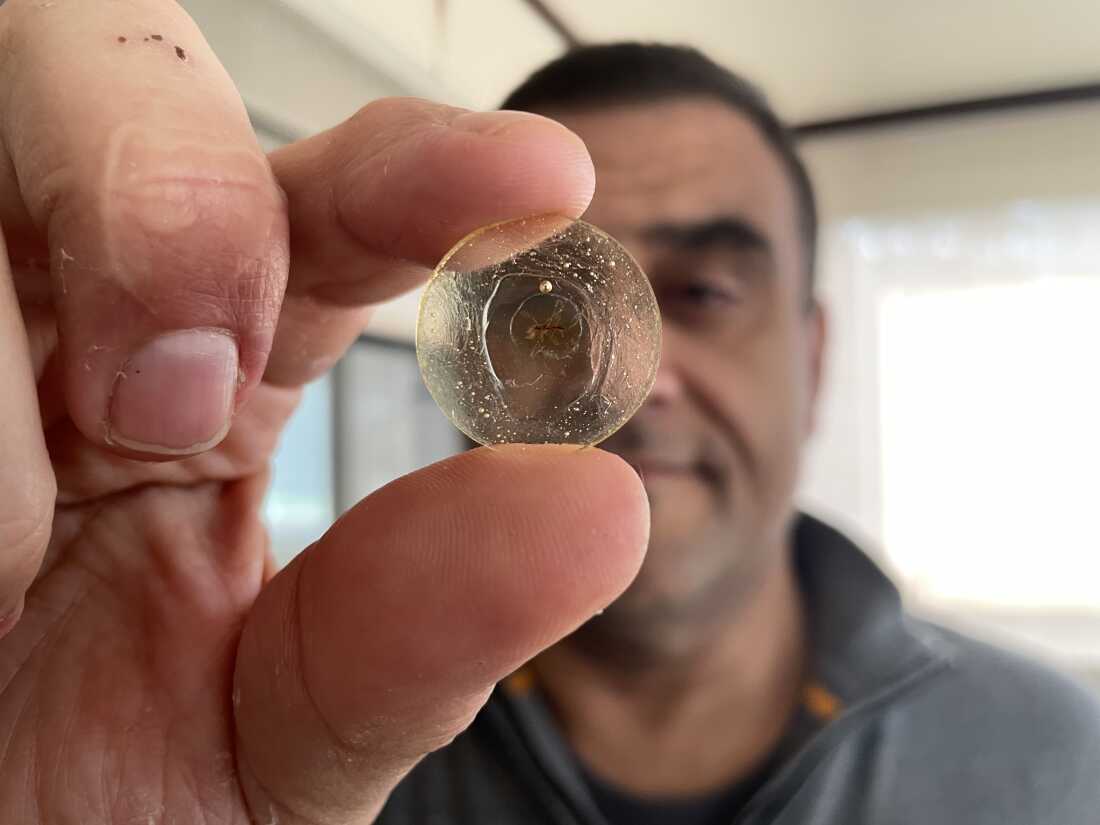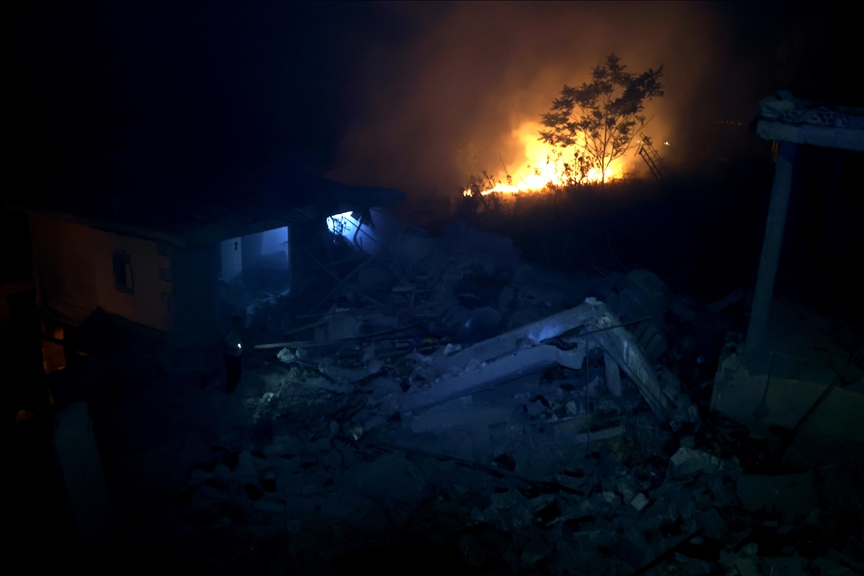
WORKSHOP PARTICIPANTS IN UNALASKA, AK
© NADINE KOCHUTEN / ALEUT INTERNATIONAL ASSOCIATION
28 JUNE 2024
Solid waste management practices in small, remote Arctic communities can pose significant human health, environmental and economic concerns. Communities often face challenges such as geographic remoteness, limited infrastructure and resources, harsh weather and changing climate conditions, among other things.
This has led to countless uncontrolled open solid waste dumpsites across the Arctic. These pose a wide range of hazards to local communities including co-mingling of sewage wastes, dumping of prohibited waste, and uncontrolled burning and seepage into water bodies. Often lacking an operator, systematized collection and access to cover materials, waste management is further hampered by coastal flooding, erosion and thawing permafrost, limiting access and control of sites.
Indigenous communities can face health and environmental impacts from these open dumpsites. There is a deep connection to environmental stewardship, and a subsistence diet among Indigenous communities, and solid waste can jeopardize the safety and security of their cultures and foods.
Two Arctic Council Working Groups – the Sustainable Development Working Group (SDWG) and Arctic Contaminants Action Program (ACAP) – have initiated a number of projects to address this issue over the last decade.

© NADINE KOCHUTEN / ALEUT INTERNATIONAL ASSOCIATION
A TIMELINE OF SOLID WASTE MANAGEMENT ACTIVITIES IN THE ARCTIC COUNCIL
In 2016, the ACAP workshop, “Sharing Approaches on Community Solid and Hazardous Management Within Arctic Indigenous Communities” (Nome, Alaska 2016), identified community priorities, best practices, and the need for a clearing house of solid waste information. Then in 2018, SDWG initiated a desk study, “Best Waste Management Practices for Small and Remote Arctic Communities”, which provided an overview of best waste management practices from Alaska, Arctic Canada and Finland, as well as recommendations on possible actions.
From the start, Indigenous Peoples’ organizations have been the driving force behind solid waste initiatives under the Arctic Council.
From 2018-2021, inventory and clean-up efforts in Sámi communities on the Kola Peninsula were planned and carried out under ACAP’s Kola Waste project by the Public Organization for Promotion of Legal Education and Preservation of the Cultural Heritage of the Sámi of the Murmansk Region (OOSMO) in partnership with the Saami Council, and supported by the Indigenous Peoples’ Contaminant Action Program (IPCAP) Expert Group under ACAP.
The project comprised an inventory and classification of illegal waste dumps in and around thirty communities followed by a first clean-up of most of the sites, which could be handled without special treatment or licenses. The project was conducted in close cooperation between the Sámi communities and the local and regional environmental authorities.
WORKSHOP PARTICIPANTS IN UNALASKA, AK LEARNING HOW TO PREPARE AND PALLETIZE RECYCLING TO BE SHIPPED OUT OF THE COMMUNITY.
© NADINE KOCHUTEN / ALEUT INTERNATIONAL ASSOCIATION
THE SOLID WASTE MANAGEMENT IN REMOTE ARCTIC COMMUNITIES PROJECT
As the next step to help understand and address different concerns related to solid waste management in remote Arctic communities, ACAP and SDWG are collaborating on a project to provide information, training, tools and other resources to improve planning and implementation of solid waste management practices in these communities. The project is co-led by the Aleut International Association (AIA), Saami Council and several Arctic States.
The project leads are committed to building on previous work to scale up solid waste management activities that assist, not only the pilot communities, but also other Arctic communities that face similar challenges. The project also builds on previous Arctic Council work on marine litter and plastics carried out by the Protection of the Arctic Marine Environment (PAME) and Arctic Monitoring and Assessment Programme Working Groups.
As part of a pre-project scoping effort in the U.S., AIA aimed to evaluate small, remote Arctic communities’ solid waste management practices, challenges, and new solutions. The assessment method involved a voluntary survey of small Arctic communities (fewer than 1,500 inhabitants), which are either off the road system for at least three months of the year, or, which, due to their location, encounter logistical or affordability obstacles in accessing regional or national solid waste support services and facilities.
The results indicated a top five of challenges related to solid waste management:the need for stronger or enhanced regulations;
the need to replace or improve the landfill;
the lack of regional facilities to support the community with its waste management;
insufficient resources to maintain the landfill and equipment they do have; and
the need for additional staff to operate the landfill.
Survey respondents ranked the top five most helpful actions to address solid waste challenges their community faces as:in-person training;
educational materials for residents;
targeted public service messages via radio and social media;
culturally appropriate approaches for educating community members;
and training focused on landfill operations.
The assessment identified human drivers as crucial in ensuring effective solid waste management. Individuals or groups deeply committed to improving solid waste management and motivating the community can make a difference even when resources are scarce. This conclusion was also proven by the Kola Waste project, which became possible due to the aspirational leadership of several community members. Community support and compliance are also important drivers for success.
Another scoping assessment made for the U.S. Environmental Protection Agency by the Battelle Memorial Institute provides a circumpolar overview of solid waste management in remote Arctic communities. It describes challenges, opportunities and some of the best practices, as well as suggests some ideas for future pilot projects that could serve as next step to improving solid waste management in the Arctic. The findings were derived from a literature review, environmental scan of online materials, and key informant interviews with experts working on solid waste management in the Arctic.
The report covers a variety of different waste types that appear in the Arctic region. Some of these waste types are common around the globe (e.g., marine debris and plastic pollution) and will require solutions at both local and global levels to make an impact. Some other types of waste are found elsewhere but are of particular concern in the Arctic due to context-specific limitations (e.g., construction and demolition waste).

© NADINE KOCHUTEN / ALEUT INTERNATIONAL ASSOCIATION

© NADINE KOCHUTEN / ALEUT INTERNATIONAL ASSOCIATION
ON TO THE PILOT PHASE
Both assessments show that solid waste management in the Arctic poses unique challenges, especially for small, remote, and Indigenous communities. While every country, region, and community will need customized solutions, lessons learned could be shared across countries where appropriate. So, one of the important deliverables of this project is a tool kit on solid waste management compiled by AIA.
Currently, the project leads are working to identify pilot communities in Alaska, Arctic Canada and Sápmi. They are looking for pilot solid waste improvement projects that will have a replicable component to serve as a model for lessons learned for other remote communities in the Arctic.
The pilot phase of the project will benefit from greater degrees of collaboration between local, regional, national, and international parties. Another important part of the project will be an in-person workshop, which will convene participants of different community-based pilot projects for information sharing and building relationships with their counterparts. A strong youth component will be important to share knowledge and generate solutions.
There is no one-size-fits-all solution to effective waste management in the Arctic, highlighting the importance of community-driven projects that address their specific issues and needs. However, many communities around the circumpolar north experience similar conditions such as remoteness, limited infrastructure and harsh weather. By focusing on several pilot communities across regions, best practices can be scaled up and shared to benefit many other communities around the Arctic.
I see tents, empty oxygen tanks, broken ropes, and worn-out equipment piling up on the slopes. It amounts to tons of garbage year after year. When I lay my eyes on this sight it chokes me, and I know that the slow decomposition of these non-biodegradable materials pollutes the soil and water.
June 28, 2024

JOURNALIST’S NOTES
INTERVIEW SUBJECT
Kristin Harila, originally from the flat village of Vadsø, is a self-made icon in the mountaineering world. Born with a passion for the outdoors, she quickly developed a love for winter sports and cross-country skiing. However, her fearless attitude and exceptional talent for mountaineering set her apart. After resigning from her management position in 2019, Kristin dedicated herself to climbing the world’s highest peaks. In 2023, she and Tenjin (Lama) Sherpa set the world record for summiting three of the 14 peaks over 8,000 meters in just 3 months and 1 day, cementing her place among the best mountaineers globally. Learn more about her efforts and the Tenjen-Harila cleanup project.
BACKGROUND INFORMATION
Mount Everest has witnessed countless human feats and epic challenges over the decades. However, the constant climbing of the mountain has created a significant environmental problem: the accumulation of garbage. Due to the increased popularity of Everest as a mountaineering destination and the difficult decisions climbers face regarding what to take and what to leave behind to ensure their survival, the amount of trash left on the mountain has grown substantially.
Nepalese authorities are now considering new measures to prevent the further deterioration of the Himalayan mountains’ fragile ecosystem caused by the annual accumulation of garbage left by expeditions. These measures aim to preserve the natural splendor of Everest while maintaining its status as a premier destination for climbers worldwide.
For more information, visit the CNN Español report.
MOUNT EVEREST, Nepal — From my base camp at Mount Everest in the ice and cold, trash seemed to swallow the mountain. The landscape was marred by a plague of garbage. I felt shocked as I witnessed it and decided to do something to reverse the situation.
Today, wearing a down jumpsuit with the Norwegian flag, I climb to the 8,611-meter peak, clearing the route of worn-out oxygen cylinders, tattered tents, and ropes discarded by climbers over the decades. In one week, my team and I collected over 200 kilos of garbage. For me, the effort serves as a tribute to the mountain, and I do this work from the heart.
Read more environment stories at Orato World Media.
Launching a cleanup initiative on Mount Everest
Year after year, I saw more and more garbage pile up at Mount Everest, so I started a cleanup project. This year, I visited all the camps including the summit, cleaning garbage with my team. Removing the waste requires huge groups of people. The work remains difficult and dangerous.
The highest peaks record temperatures of 60 degrees below zero and winds up to 200 kilometers per hour in winter. These winds transport the debris and garbage, making some areas deadly. They are so fierce and biting, they pose a constant threat to our stability. My team and I often struggle to keep our balance.
Despite these challenges, I enjoy climbing Everest in good weather. I gaze up at its steep majesty, so high I can contemplate hundreds of other peaks surrounding me. It feels like my place in the world. However, as the weather worsens, I walk the slopes, my vision blurred by an incessant curtain of white snow. The threat of slippery ground and columns of glacial ice known as seracs loom.
The death zone at Mount Everest proves so extreme, if I or any climber suffers from altitude sickness, frostbite, or an accident, rescue becomes virtually impossible. The very low temperatures and the difficulty of the terrain at high altitudes forces us to take three breaths for each step, even for an experienced climber. My heart races to supply oxygen more frequently. Not even a helicopter can rescue someone at that altitude.
Nevertheless, I have fought for my place on the fixed ropes with dozens of climbers stuck along the way. Making records, like climbing the 14 giants of the earth faster than anyone else in three months and one day, seems like science fiction. In this harsh scenario, amidst such pressing conditions, when I take garbage back down the mountain, I gamble with my life.
Surge in hikers leaves mountains of garbage behind
As Everest’s popularity as a mountaineering destination grows, a significant increase in people seeking to reach its summit ensues. This generates a noticeable amount of waste. I ask myself, “What price does the mountain and the environment pay?” Little by little, I see how people destroy its beauty and ecosystem, causing irreparable damage. I witness the great demand of neo-alpinists willing to pay very high sums of money to fulfill a dream without giving up certain comforts.
At the base camp located at 5,364 meters, it resembles a bustling village with corridors and streets formed by dozens of tents that look more like inns, complete with televisions. It’s crazy. At Camp Two, at 6,500 meters, I see even more impressive facilities. Tents offer heating, internet, a wooden bed, and a mirror, along with unlimited oxygen. However, they often leave the equipment behind from one year to the next. As a result, uncontrolled waste management occurs, creating real chaos.
This starkly contrasts my experience as a true mountain climber with those who are not. True climbers venture only with the essentials, while others require every comfort to ascend. Everest now overflows with garbage. Most climbers discard their gear on the mountains because, after summiting, exhaustion takes over, and survival becomes the only priority.
I see tents, empty oxygen tanks, broken ropes, and worn-out equipment piling up on the slopes. It amounts to tons of garbage year after year. When I lay my eyes on this sight it chokes me, and I know that the slow decomposition of these non-biodegradable materials pollutes the soil and water. The situation proves even worse at the last camp on the normal route, located at more than 7,900 meters on Everest’s South Col, where garbage often remains forever.
Beyond inorganic waste: the grim reality of human corpses on Everest
Over the years, I witnessed piles of empty oxygen cylinders, plastics, human waste, and abandoned tents accumulate in Everest’s crevasses, turning them into tattered rags flapping in the wind. Abandoned ropes mislead teams off-route, while discarded tents force climbers to set up in more exposed areas, increasing the risk of fatal falls.
As I climb, some areas stink from the waste. I find it unbelievable that people set up tents with kitchens and leave everything behind. South Col has become a shocking sight. In addition to inorganic garbage, Everest harbors a grim record of human corpses. Some remain for years, while others emerge as glaciers melt due to climate change.
In July 2023, together with Tenjen Lama Sherpa, I set the world record for climbing the fourteen 8,000-meter mountains in 91 days. The most heartbreaking experience of my life was Tenjen’s death in August of the same year. He fell from a cliff, and despite our efforts to rescue him, the low oxygen, narrow path, and difficult conditions forced us to leave him behind. I plan to return to the mountain in October to find his body and return him to his homeland and family.
This mission is not just about bringing him back; it’s a personal journey to find closure and peace. Climate change exacerbates the challenges on Everest. Rising temperatures melt glaciers, revealing trash from early expeditions. The glaciers’ continuous movement uncovers new waste annually. Despite the hard and dangerous task, I am committed to preserving the mountain’s beauty and integrity.

















Chinese President Xi Jinping delivers a speech at the Conference Marking the 70th Anniversary of the Five Principles of Peaceful Coexistence in Beijing, China, June 28, 2024. /Chinese Foreign Ministry
The Five Principles of Peaceful Coexistence were proposed 70 years ago.
Having emerged in a complex historical context, the five principles have been gradually accepted by countries worldwide and become fundamental norms for maintaining international peace and security and promoting friendly relations among nations.
At a commemorative conference marking 70 years of the principles, held by China on Friday, Chinese President Xi Jinping called for the principles to be carried forward to build a community with a shared future for mankind and provide a strong driving force for human progress.
'Firm resolve' to peaceful development
In 1954, then Chinese Premier Zhou Enlai put forth in full the Five Principles of Peaceful Coexistence for the first time – mutual respect for sovereignty and territorial integrity, mutual non-aggression, non-interference in each other's internal affairs, equality and mutual benefit, and peaceful coexistence.
Later, these principles served as guidelines for countries with different historical and cultural backgrounds, social systems and national conditions to handle their interrelations.
Noting the five principles have withstood the test of international vicissitudes, Xi said in the speech at Friday's conference that 70 years on, China has answered the call of the times by proposing a community with a shared future for mankind.
The Chinese president said that the Vision of Building a Community with a Shared Future for Mankind, carrying forward the spirit of the five principles, is the most effective way to sustain, promote and upgrade these principles, demonstrating China's firm resolve to follow the path of peaceful development.
China is the only country in the world that has incorporated peaceful development in its Constitution, and the only country among the five nuclear-weapon states to pledge no first use of nuclear weapons.
In April 2022, China proposed the Global Security Initiative to create a new path to security featuring dialogue over confrontation, partnership over alliance, and win-win over zero-sum. Under its guidance, the country released papers on its position on resolving the Ukraine crisis and the Palestinian-Israeli conflict, respectively, urging political settlement and diplomatic mediation.
Guiding Global South cooperation
The five principles were initiated with the purpose of protecting the interests and pursuits of small and weak countries from power politics. As the international order is being rebuilt based on South-South cooperation, the five principles are gaining ground and guiding solidarity and collaboration among Global South countries.
Under the China-proposed Belt and Road Initiative (BRI), many participating countries have reinforced their capacity of development through cooperating with China on fields including transportation, agriculture, energy and communication.
This is demonstrated by BRI landmark projects such as the China-Laos Railway which turned landlocked Laos into a land transport hub, Kenya's Mombasa-Nairobi Railway which contributes two percent to the African nation's economic growth, and Indonesia's Jakarta-Bandung High-Speed Railway, the first high-speed railway in Southeast Asia.
In the speech, Xi put forward a series of suggestions to better support Global South cooperation, such as providing 100,000 training opportunities to Global South countries in the coming five years, discussing free trade arrangements with more Global South countries, and welcoming more Global South countries to join the Initiative on International Trade and Economic Cooperation Framework for Digital Economy and Green Development.
He noted that China's imports from fellow developing countries are expected to exceed $8 trillion between now and 2030.
"Standing at a new historical starting point, the Global South should be more open and more inclusive, and join hands together to take the lead in building a community with a shared future for mankind," said the Chinese president.